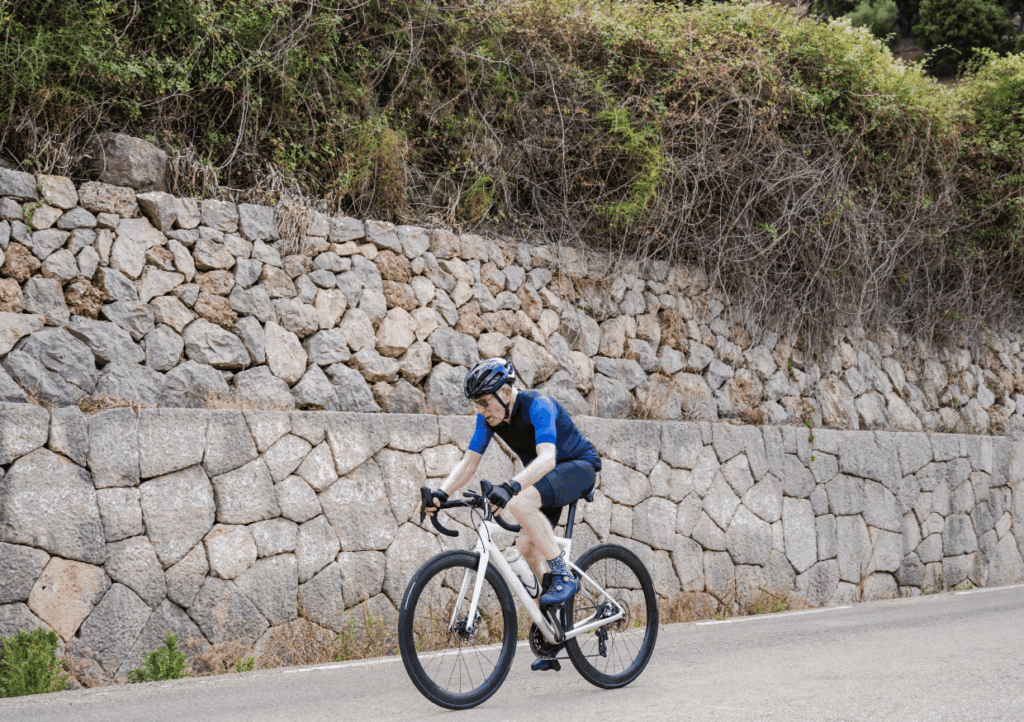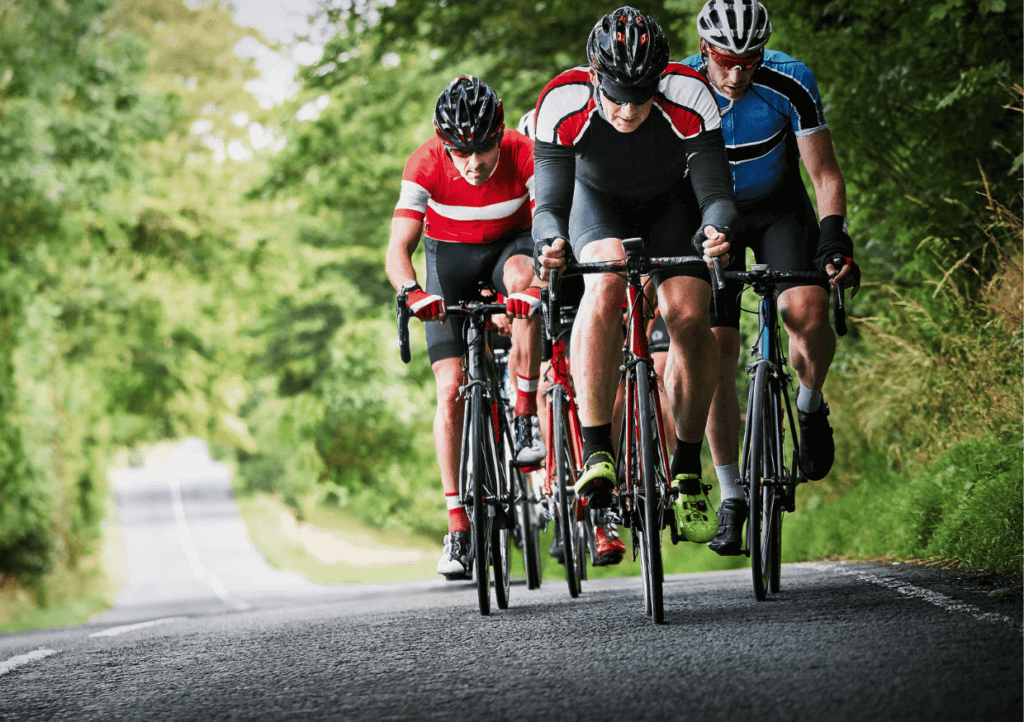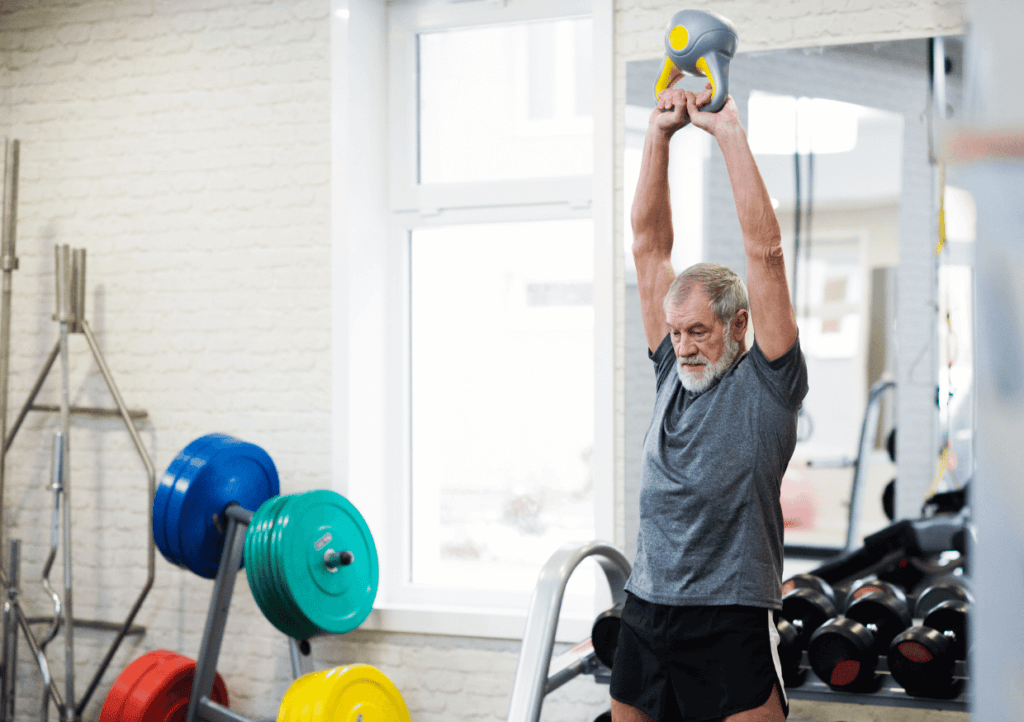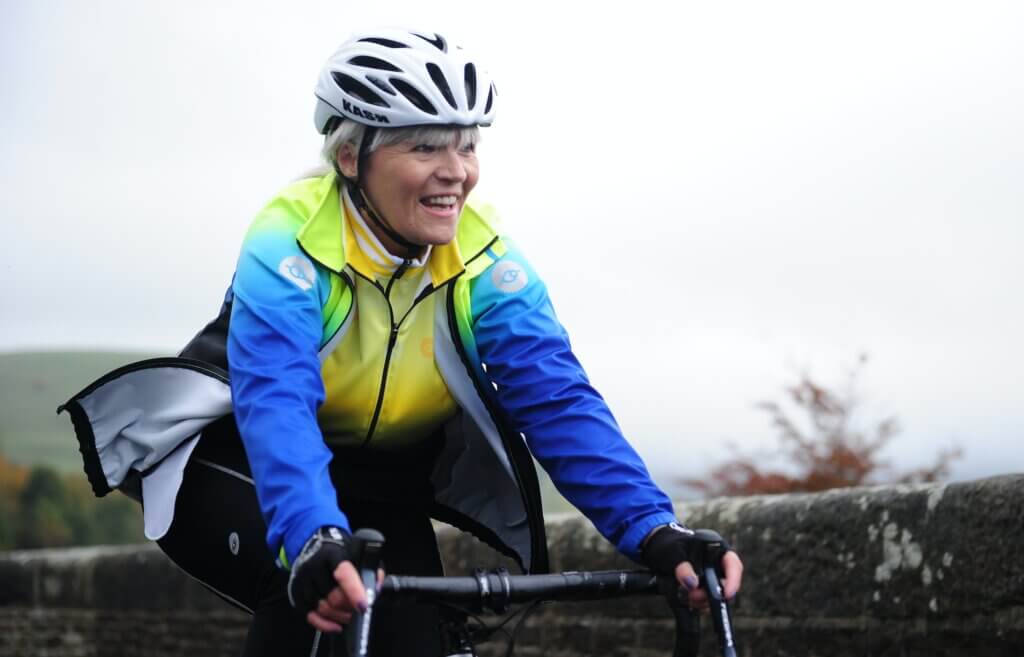Table of Contents
Getting older is no excuse to abandon your passion for cycling. Cycling transcends age barriers, and it’s a sport that offers timeless joy and adventure. As you enter your 50s and beyond, road cycling becomes an ideal means to stay active and engaged in life.
In this comprehensive article, we’ll delve into a range of training tips specifically tailored for cyclists over 50. Whether you’re a seasoned cyclist or someone new to the sport, these insights will help you reach new peaks in your performance while maintaining your safety and well-being.
Benefits of Cycling for Over 50s

Cycling in your 50s has many benefits that go beyond just physical exercise. It’s a complete experience that not only makes you healthier but also makes you feel better emotionally and mentally. It also helps you connect with others and build friendships.
Plus, the great news is that many cyclists can keep enjoying the sport well into their 80s, which means you have many more years of cycling ahead.
Health and Fitness Benefits
One of the most compelling reasons for individuals in their 50s to embrace cycling is its exceptional low-impact nature. Cycling is gentle on the joints, making it an ideal choice for those who may be more prone to injuries or discomfort from high-impact activities.
Regular cycling sessions act as a heart-healthy exercise, stimulating your cardiovascular system and helping maintain lower blood pressure and cholesterol levels. Numerous scientific studies have shown that cyclists tend to live longer and lead healthier lives.
For instance, a recent study published in the journal Sports Medicine last year conducted an extensive analysis of 17 previous studies, which encompassed data from a total of 478,847 participants. The results were striking, revealing that regular cyclists had a remarkable 23% better chance of avoiding premature death. Furthermore, the study showed that cyclists also benefit from a significantly reduced risk of cardiovascular illnesses.
Moreover, cycling actively engages your muscles, contributing to enhanced muscle tone and overall strength. Your legs, in particular, experience a significant workout as you pedal, helping you maintain or even build lean muscle mass. This is particularly beneficial as it counteracts the natural muscle loss that occurs with age.
Additionally, cycling aids in weight management. It’s a calorie-burning activity that assists in maintaining a healthy body weight, which is especially important for individuals over 50. As you cycle, you engage in a full-body workout, effectively burning calories and increasing your metabolic rate. The result? Better weight management, which, in turn, contributes to overall health and longevity.
The efficiency of your heart and lungs increases as you cycle regularly. These organs become more adept at supplying oxygen to your body’s tissues, ensuring that you stay energized and vibrant.
This increased cardiovascular efficiency not only promotes physical health but also influences your daily life, making it easier to tackle daily tasks and enjoy activities outside of cycling.
Mental and Emotional Well-being
Cycling offers more than just physical benefits; it’s a fantastic mental workout as well. When you hit the open road on your bike, you experience a sense of freedom and escape from the stresses of daily life.
The rhythm of your pedaling, the wind against your face, and the changing scenery can help you achieve a state of mindfulness, reducing stress levels and promoting mental clarity.
Regular cycling can be an oasis of calm in the midst of a busy life. It allows you to disconnect from screens, emails, and the demands of the modern world, giving your mind a much-needed break.
As you cycle, you can experience the meditative effects of focusing on the simple act of pedaling, helping you find mental balance and tranquility.
Engaging in cycling can also lead to a profound sense of accomplishment and contentment. Setting and achieving cycling goals, whether it’s conquering a challenging hill or completing a long-distance ride, can boost your self-esteem and overall sense of well-being.
These achievements offer a tangible sense of accomplishment, which, in turn, can improve your emotional health.
Social Connection
Cycling, as a social activity, is not confined to any specific age group. Regardless of your age, cycling offers abundant opportunities to connect with others who share your passion. It provides ample occasions to join cycling clubs and participate in group rides, fostering camaraderie and expanding your social circle.
When you join a cycling group, you become part of a supportive community that shares your enthusiasm for the sport. This sense of belonging is particularly beneficial for individuals in their 50s who may be experiencing significant life transitions, such as retirement or children leaving home.
Cycling clubs offer a sense of purpose, shared goals, and a network of like-minded individuals who can provide both emotional and practical support.
Group rides further enhance your social connections. The shared experiences on the road, whether it’s conquering a challenging climb or enjoying the picturesque countryside, can lead to lasting friendships.
These bonds can extend beyond the road, providing companionship and social interactions that are invaluable for emotional well-being and overall quality of life. Whether you’re a novice or a seasoned cyclist, the sense of community in cycling groups can be a source of lifelong friendships and enriching social connections.
Assessing Your Current Fitness Level

Assessing your current fitness level is the foundational step in any successful training program, and for cyclists over 50, it’s particularly important to ensure that your training is tailored to your unique needs and abilities.
Medical Check-up
An annual medical check-up should be a routine part of your plan, regardless of your age or fitness level, as it is important for both men and women over 50. Cyclists are no different in this regard, and the benefits of regular health check-ups apply to all.
During your medical check-up, your healthcare professional will perform a comprehensive evaluation of your overall health and well-being. This evaluation goes beyond just your physical health; it encompasses your medical history, any pre-existing conditions, and your current state of health.
One of the primary benefits of this medical check-up is that it can help identify any underlying medical conditions that might require special attention or adjustments in your training plan.
Even being a fit cyclist doesn’t make you immune to some health issues occurring. It also offers a valuable opportunity to discuss your fitness goals and ambitions with a healthcare professional who can provide tailored advice.
Receiving a clean bill of health during your medical check-up provides the reassurance that you are physically capable of engaging in this physically demanding sport. However, it’s also crucial to continue to monitor your health throughout the year, and visit your doctor if you have any concerns.
Fitness Evaluation
Beyond the medical check-up, a comprehensive fitness evaluation is the next step. This evaluation is your opportunity to gauge your current physical capabilities and establish a baseline for your fitness level.
A fitness evaluation includes a range of assessments that cover various aspects of your physical condition. These may include cardiovascular endurance tests, strength assessments, flexibility measurements, and balance checks.
The combination of these tests provides a comprehensive overview of your strengths and areas that may need improvement.
Understanding your current physical state is essential for creating an effective and safe training plan. It allows you to set realistic goals, taking into account your starting point, and prevents overexertion that could lead to injury or burnout.
Moreover, a fitness evaluation helps tailor your training program to match your fitness level and desired objectives.
It’s important to remember that these assessments are not meant to judge your fitness but to provide a roadmap for improvement. They offer insights into your areas of strength and those where you can make gains.
Regular fitness evaluations can also be a motivating tool as you see improvements over time, which can be especially rewarding for those over 50, as it demonstrates the continued potential for growth and progress.
Designing Your Training Plan

When it comes to cycling in your 50s and beyond, a well-crafted training plan is the cornerstone of your success. Such a plan is not a one-size-fits-all endeavor; it is a highly individualized road map to achieving your cycling goals.
The specifics of your training regimen depend on various factors, including your current fitness level and your aspirations.
Goal Setting
Your training plan begins with setting clear and achievable objectives. Goals act as the guiding stars of your cycling journey. They provide direction, motivation, and a sense of purpose.
Whether your aims revolve around conquering a challenging long-distance ride, enhancing your overall fitness, or reaching specific milestones within your cycling journey, well-defined goals are essential.
For some, it’s about continuing to race competitively and maintaining their competitive edge in the cycling world. For others, it’s about taking up cycling as a hobby to improve fitness and enjoy the open road.
Periodization
Understanding the concept of periodization is another critical aspect of designing your training plan. Periodization involves breaking your training into distinct phases, each with its own focus.
These phases allow for progression without risking burnout or injury. As an older cyclist, you can adapt periodization to align with your specific needs and preferences. This might involve adjusting the duration of phases or placing a greater emphasis on recovery and injury prevention.
Here’s how it might look in reality for a cyclist over 50:
1. Base Phase: This phase typically occurs during the off-season or when you’re just starting your training. It focuses on building a foundation of fitness. You might aim to increase your weekly mileage gradually, focusing on longer, slower rides. For an older cyclist, this phase can be adapted to include more recovery days or active rest days to prevent overuse injuries.
2. Build Phase: As your fitness improves, you’ll move into the build phase. This phase introduces intensity with interval training, hill climbs, and tempo rides. For a competitive racer, this phase might include specific race simulations. However, for someone cycling as a hobby for fitness, this phase could entail hill rides and faster-paced group rides to enhance overall endurance and strength.
3. Peak Phase: This phase is all about fine-tuning your performance. For a competitive cyclist, it might involve intense race-specific training and peaking for key events. For a recreational cyclist, it could involve setting personal challenges, like completing a metric century or a hilly route, to test your fitness and achieve new milestones.
4. Transition Phase: After intense training, it’s crucial to allow your body to recover. The transition phase involves lighter training, cross-training, or even a short break from the bike. As an older cyclist, you may prioritize recovery during this phase, focusing on yoga, stretching, and activities that promote flexibility and reduce muscle soreness.
5. Maintenance Phase: This phase is where older cyclists may differ the most. For competitive racers, it’s about maintaining fitness. However, if you’re cycling for health and enjoyment, this phase might involve keeping a consistent, moderate training load to sustain fitness levels.
6. Event Phase: For competitive cyclists, this phase includes racing or participating in key events. But even if you’re cycling as a hobby, the event phase could mean tackling your goal rides, like charity events, group rides, or personal challenges.
Building an Individualized Training Program

The journey to becoming a successful cyclist over 50 begins with crafting a personalized training program. Each cyclist is a unique individual with specific needs, preferences, and constraints.
A one-size-fits-all approach might not be suitable for everyone. Thus, tailoring your training program to align with your distinct characteristics is crucial. A personalized training plan takes into account your fitness level, goals, available time, and your body’s specific requirements.
By doing so, you can make steady progress without overexertion, reduce the risk of injuries, and, most importantly, stay motivated and engaged throughout your cycling journey.
Your program may include a mix of endurance, strength, and interval workouts, adjusted to your capabilities and objectives. If you have limited time to spare, a well-structured plan ensures that your training is both efficient and effective, allowing you to make the most of your available time.
If you need assistance with creating a personalized training plan, consider consulting a cycling coach who can provide expert guidance and tailor your program to your specific needs.
Training Zones
Understanding your training zones is a critical aspect of effective cycling training. Training zones are defined by your heart rate, power output, or a combination of both. By monitoring and staying within your designated zones, you can tailor your workouts to match the right intensity for your specific goals.
For cyclists over 50, training zones provide a precise guide to ensure you are training at the right intensity for your age and fitness level. Whether you aim to improve endurance, boost strength, or increase speed, your training zones serve as a compass, allowing you to navigate your workouts with precision.
Endurance Rides
Endurance rides serve as the bedrock of any cyclist’s training program, and they are particularly crucial for cyclists over 50. These rides are designed to build stamina by gradually increasing your cycling distance and duration, contributing to a solid foundation for your cycling fitness.
For cyclists over 50, achieving peak performance and maintaining overall fitness is all about balance. Instead of pushing for excessive training hours, it’s essential to focus on quality over quantity.
A sweet spot for many is around 8-10 hours of consistent training per week. This range helps build general fitness without overexertion. Going beyond this can lead to diminishing recovery capacity, decreased power, and dwindling motivation, resulting in inconsistent training.
However, if you have substantial experience or are preparing for events, you might aim for 8-12 hours of training per week, with occasionally reaching 12-16 hours for a final push before an event.
It’s crucial to be smart and set limits based on your fitness level and daily schedule. Your training hours may vary based on your goals, upcoming events, and training history. Always align your training volume with what’s realistic for your lifestyle and fitness aspirations.
During endurance rides, it’s essential to maintain a long and steady pace. This steady pace allows your body to adapt to the sustained effort, improving your aerobic capacity and enhancing your endurance. These rides are ideal for building the cardiovascular and muscular endurance needed for long-distance cycling.
To get the most out of your endurance rides, monitor your heart rate. Heart rate monitoring ensures that you are staying within your designated training zone, which is essential for effective endurance training. It helps you maintain an appropriate intensity level and track your progress over time.
Endurance rides are well-suited for group rides, as the camaraderie and conversations can make the journey even more enjoyable. However, when participating in group rides, be mindful that the group’s pace is suitable for your goals and fitness level.
It’s important to find a balance between challenging yourself and ensuring that the pace remains within your desired training zone.
As you conquer longer distances and ride through challenging conditions, you’ll build the mental resilience necessary to tackle more extended and demanding routes. The mental strength gained during endurance rides will serve you well in your cycling journey, helping you overcome obstacles and push your boundaries.
Interval Training
Interval training is a fundamental component of enhancing cycling performance, and it holds particular importance for cyclists over 50. The aging process tends to slow down fast-twitch muscle fibers, which are responsible for those explosive bursts of power and speed crucial for competitive cycling.
By incorporating interval training into your routine, you challenge your fast-twitch muscles, preventing them from losing too much speed. These high-intensity intervals involve short bursts of effort at near-maximum intensity followed by periods of active recovery.
However, it’s important to note that interval training can be demanding, and the intervals designed for cyclists in their 20s may not be suitable for those over 50. As we age, recovery times become more critical to avoid overexertion and potential injury.
For cyclists in the 50-plus age group, a recommended approach to interval training is to start with 2 sets of 2 x 5-minute intense efforts, followed by 5 minutes of active recovery, totaling 20 minutes. If you’re new to cycling and training, it’s advised to begin with 3 x 5-minute intense efforts and 5 minutes of active recovery.
By doing slightly less intense intervals, you can allow your body to recover from the workout and be better prepared for the next one. Consistency and patience are key in achieving optimal results.
The structured nature of interval training allows you to progressively challenge yourself, stimulate neuromuscular adaptations, and enhance your cycling performance without risking overexertion or injury.
It not only supports your speed but also bolsters your overall cycling capabilities, including cardiovascular health, lactate threshold, and the ability to handle intense efforts.
With interval training, you’ll experience gains in power and endurance, ultimately making your rides more enjoyable and rewarding, regardless of your age.
Strength and Flexibility Training

For cyclists over 50, a well-rounded training routine should include a focus on both strength and flexibility. This combination is essential for maintaining muscle tone and preventing injuries, allowing you to enjoy your cycling experience to the fullest.
Resistance Training
Resistance training is a key component of any strength-focused regimen. By incorporating resistance exercises into your training routine, you can target specific muscle groups and improve overall muscular strength.
These exercises often involve the use of resistance bands, dumbbells, or body weight to create controlled resistance against your muscles. Not only does this help in building muscle and boosting power, but it also enhances bone density, which becomes increasingly important with age.
Strength training has a direct impact on your cycling performance. It enables you to generate more power with each pedal stroke, which is crucial for conquering steep inclines and maintaining a consistent pace on long rides.
As you build muscle, you’ll notice improved endurance and a reduced risk of fatigue. This means you’ll be able to tackle longer distances with greater ease, ultimately making your cycling adventures more enjoyable and efficient.
Moreover, resistance training is a great way to prevent the age-related loss of muscle mass and strength, which can occur as you get older. By engaging in regular strength workouts, you can counteract the natural decline in muscle mass and keep your body strong and resilient.
Yoga and Stretching
As a cyclist, flexibility is key to maintaining a comfortable and injury-free riding experience, especially as you age. Yoga and regular stretching sessions are invaluable for enhancing your flexibility and balance.
Yoga, in particular, offers a holistic approach to stretching and flexibility. It combines poses and stretches that not only increase your range of motion but also enhance your balance and core strength.
Poses like the Downward Dog, Child’s Pose, and Pigeon Pose can target tight areas like the hamstrings, hip flexors, and lower back, which are common culprits of discomfort for cyclists. Post-ride static stretches can aid in muscle recovery and reduce the risk of cramps or stiffness.
By prioritizing flexibility through yoga and stretching, you’ll not only be able to reach more comfortably for those handlebars but also maintain proper posture on the bike. This is crucial for minimizing the risk of overuse injuries and ensuring that each ride is a pleasant and pain-free experience.
Recovery and Injury Prevention

Taking care of your body is paramount for cyclists over 50. Ensuring that you incorporate adequate recovery and injury prevention strategies into your training plan is a key element in achieving long-term cycling success.
Importance of Rest
Rest is a fundamental pillar of any successful training regimen, and its significance is amplified for cyclists over 50. During periods of rest, your body undergoes essential repairs and reconstruction, enabling it to adapt to the physical demands of cycling.
Without adequate rest, your journey can be derailed by the twin risks of burnout and overuse injuries, both of which can set back your progress significantly. Furthermore, as you age, your body’s recovery needs may increase, underscoring the critical role of rest.
One vital aspect of rest that cannot be emphasized enough is the importance of quality sleep. Quality sleep is the linchpin of effective recovery and adaptation to training. Without it, your ability to progress and reach your cycling goals will be compromised.
Therefore, listening to your body and prioritizing rest, including quality sleep, is a non-negotiable aspect of your training journey.
Injury Prevention Strategies
Preventing injuries is another vital aspect of cycling over 50. The wear and tear on your body can accumulate over time, making it crucial to adopt injury prevention strategies.
One of the first steps is to become familiar with common cycling-related injuries, such as knee pain, lower back issues, or wrist strain. By understanding these potential pitfalls, you can take proactive measures to prevent them.
Maintenance of proper bike fit is essential. An ill-fitted bike can lead to various discomforts and injuries. Ensuring that your bike is adjusted to suit your body proportions is key. Moreover, focus on maintaining the right posture during your rides.
This means keeping your back straight, your shoulders relaxed, and your arms slightly bent. Poor posture can result in muscle strain and discomfort, so being mindful of your body’s alignment while cycling can make a significant difference.
Technique also plays a crucial role in injury prevention. Learning how to pedal efficiently, change gears smoothly, and maintain control over your bike can minimize the risk of accidents or overuse injuries.
Whether you’re a seasoned cyclist or a newcomer, it’s never too late to fine-tune your technique, ensuring a safer and more enjoyable cycling experience as you continue to pursue your passion. Remember that injuries can lead to extended time away from the bike, which can substantially impede your fitness progress.

